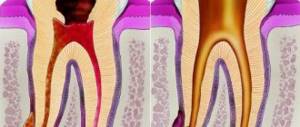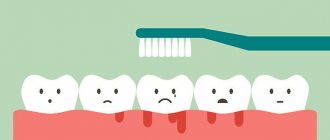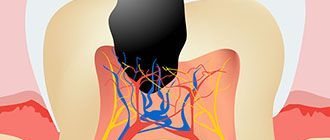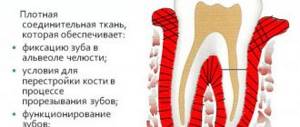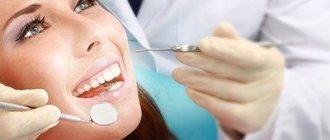Types of disease
Traumatic periodontitis
Even a poorly made prosthesis or a low-quality filling can put traumatic pressure on the root of the tooth. Unfortunately, traumatic periodontitis can be supplemented by infectious periodontitis. With a specific allergy to strong dental preparations, inflammation can also form.
Acute periodontitis
The process can be acute, and the patient will definitely notice it. Acute periodontitis always goes away with pain, which is quite difficult to ignore.
Chronic periodontitis
But chronic disease can last for quite a long time with mild, not very alarming symptoms. Sometimes this is a change in the color of the gums or teeth, an unpleasant odor, and the body temperature may rise slightly.
And any of these types of periodontitis requires urgent medical attention, so at the slightest symptoms, go to a good dentist at the A.Dent clinic.
Symptoms
Symptoms of traumatic periodontitis in acute cases are pronounced: acute pain when touched, pain when chewing and with any mechanical impact. Mobility is also present to a greater or lesser extent. The color of hard tissues changes, which is caused by profuse bleeding inside the tooth.
In the chronic course of traumatic periodontitis, there is slight pain when tapping. Mobility appears, which increases over time, or its tilt with displacement.
Treatment
Opening and cleaning the canal
Usually, when periodontitis is detected, the doctor has to open either a carious cavity or a damaged dental canal and clean it thoroughly. In this case, one cannot do without removing excess tissue that could be infected. Expanding the root canal is also necessary for subsequent treatment. In the acute form, such expansion has another advantage - the accumulated exudate will come out and the general inflammation will subside. In this case, the spread of infection around to other tissues will stop, and the patient will experience relief.
Disinfection of the tooth canal
Next comes the actual treatment, that is, the canals are disinfected, and then the necessary agents are injected inside. These are often very strong drugs, and the doctor’s main concern is to prevent them from getting beyond the root apex. After treatment, a course of ultrasound physiotherapy is carried out, and filling begins.
Sealing
The filling must be thorough and thorough. The entire canal, especially the apex, must be hermetically sealed with a material suitable for the specific case. If any slight gaps remain, the infection can easily return and the entire unpleasant procedure will need to be repeated.
Course of antibiotics
Then the doctor usually prescribes additional treatment - a course of antibiotics, rinsing with herbs and mineral waters, physiotherapy. This completes the treatment of periodontitis.
Diagnosis and treatment
Diagnosis of pathology includes anamnesis, examination, radiography and, if necessary, EDI (electroodontodiagnosis). After the specialist makes a diagnosis, treatment is prescribed. If in acute traumatic periodontitis the integrity of the pulp is not compromised, the affected tooth is splinted, a course of antibiotics is prescribed and the mouth is rinsed with special antibacterial solutions. To eliminate pain, anti-inflammatory drugs are prescribed. If the pulp has been damaged, intracanal tooth treatment is performed. Treatment of the chronic form of traumatic periodontitis is aimed at eliminating the factors that provoke the disease, and then at treating the pathology itself, depending on what stage of development it is at. With early diagnosis of traumatic periodontitis, the treatment prognosis is favorable. If you do not contact a dental clinic in a timely manner, the pathology can lead to irreversible and serious consequences.
Prevention of periodontitis
Unfortunately, mild forms of the disease occur in almost 70% of the Russian population, so everyone should be aware of this disease. Prevention is important, preferably from early childhood. It is necessary to learn proper oral hygiene from professionals, change toothbrushes often, and you also need to know how to choose them. The habit of regular prevention will form quickly and will relieve you of a lot of unpleasant sensations.
But if you already have symptoms, consult your dentist as soon as possible.
Traumatic periodontitis
Traumatic periodontitis
occurs as a result of short-term (acute) trauma (impact, bruise, sharp biting on a bone, inept use of dental floss, etc.) or long-term trauma of minor force (high dental filling, crown, holding foreign objects by teeth, nails, smoking pipes, musical instruments and etc.).
Depending on the type of damaging factor and the body’s reaction to it, two forms of traumatic periodontitis are distinguished - acute and chronic.
Acute traumatic periodontitis
Acute periodontal trauma usually occurs when there is a sudden and strong load on the tooth, usually due to a bruise (fall, blow, etc.). In this case, a short-term overload of the periodontal ligaments occurs, leading to their stretching and even rupture - partial or complete.
The degree of damage depends on the strength of the impact. Trauma may be accompanied by partial or complete damage to the neurovascular bundle entering the tooth through the apical openings of its roots.
Symptoms of acute traumatic periodontitis:
- Soreness or severe pain in the area of the injured tooth, significantly aggravated by any external mechanical influence (touching, closing teeth, eating).
- Mobility, from slight to significant. In the future, tooth mobility may change: towards a decrease with complete treatment or self-healing, or towards an increase, for example, with suppuration in the area of injured periodontal tissue.
- Change in tooth color. This problem does not always arise; staining of tooth tissue occurs when there is extensive hemorrhage inside it due to rupture of the vessels passing through the apical foramen of the root.
Chronic traumatic periodontitis
Prolonged, monotonous exposure to the periodontium can cause chronic traumatic periodontitis.
The cause may also be incorrect prosthetics, when there is excessive overload of the supporting teeth with a fixed prosthesis, and overload of one tooth due to an incorrect bite or excessive pressure on the tooth due to an incorrectly placed filling.
Overload is also possible with excessive exposure to the orthodontic apparatus.
Also, periodontal injuries can be due to a number of bad habits (holding a smoking pipe with your teeth) and professional activities (prolonged squeezing of a musical instrument with your teeth, holding nails by shoemakers or stripping wires by electricians, etc.).
This form can lead to the destruction of the walls of the bone socket and periodontal fibers, and subsequently to the movement of the tooth or its loosening up to complete dislocation.
Symptoms of chronic traumatic periodontitis:
- Slight pain when tapping on overloaded teeth.
- In a neglected condition - for emerging and progressive mobility.
- Changing the position of the tooth (inclination, displacement).
In most cases, x-rays show changes in the periodontium.
When treating traumatic periodontitis, first of all, it is necessary to eliminate the damage from the traumatic injury: correct the crowns, if necessary, remove excess filling, particles of the damaged tooth, and so on.
Then symptomatic treatment is indicated, including painkillers, anti-inflammatory drugs, and physical therapy. If a tooth is displaced, the vitality of the pulp and the integrity of the root are checked using x-rays and electroodontodiagnosis. 3 weeks after treatment, a repeat photo must be taken.
- Teeth - tooth structure
- Dental treatment methods
- Tooth pain
- Oral infections
- Caries - causes of caries
- Caries - complications of caries
- Caries - symptoms of caries
- Caries – treatment of caries at home
- Caries - treatment of caries
- White caries
- Superficial caries
- Average caries
- Deep caries
- Bottle caries
- Radical caries
- Dental filling
- Dental fillings
- Light-curing fillings
- Chemical fillings
- Metal fillings
- Cement fillings
- Surgical treatment of caries
- Caries - prevention of caries
- Tooth canal treatment
- Caries - diagnosis of caries
- Filling tooth canals with hot gutta-percha
- Tooth removal
- Pulpitis
- Pulpitis - causes of pulpitis
- Pulpitis - symptoms of pulpitis
- Pulpitis - prevention of pulpitis
- Pulpitis - treatment of pulpitis
- Pulpitis - treatment of pulpitis with folk remedies
- Pulpitis - diagnosis of pulpitis
- Initial pulpitis
- Acute pulpitis
- Chronic pulpitis
- Purulent pulpitis
- Chronic hyperplastic pulpitis
- Periodontitis
- Periodontitis - causes of periodontitis
- Periodontitis - symptoms of periodontitis
- Periodontitis - diagnosis of periodontitis
- Periodontitis - treatment of periodontitis
- Acute periodontitis
- Chronic periodontitis
- Acute serous periodontitis
- Purulent periodontitis
- Infectious periodontitis
- Fibrous periodontitis
- Granulating periodontitis
- Granulomatous periodontitis
- Traumatic periodontitis
- Medicinal periodontitis
- Odontogenic fistula
- Smell from the mouth
- Fluorosis
- Enamel hypoplasia
- Enamel hyperesthesia
- Increased tooth wear
- Wedge-shaped defect
- Chemical necrosis of teeth
- Tooth erosion
- Pregnancy and dental treatment
- Remineralizing dental therapy
- Dental granuloma
- Trephination of the tooth crown
- Dysgeusia
- Bruxism
- Tooth resorption
- Chemical teeth whitening
- Teeth whitening ZOOM
- Laser teeth whitening
- Whitening of pulpless teeth
- Whitening one tooth
- Teeth whitening
- History of Teeth Whitening
Classification of periodontitis
Based on the causes of occurrence, there are three types of periodontitis:
- Infectious
. Most often it is a consequence of untreated carious pulp lesions. - Traumatic
. It is caused by both single and systematic traumatic effects on the teeth. - Medicinal
. In most cases, it is a consequence of improper treatment of pulpitis, when potent drugs enter the periodontal tissue.
Depending on the nature of the course, periodontitis is of two types:
- Spicy.
- Chronic.
Acute periodontitis is easily recognized by a sharp pain localized in the diseased tooth, which can intensify over time and also become pulsating, which is a sign of the transition of serous inflammation to purulent.
With chronic periodontitis, the color of the tooth very often changes, but there is no pain and increased sensitivity to hot and cold.
Symptoms of periodontitis
Acute and chronic periodontitis manifest themselves differently.
Symptoms of acute periodontitis:
- Pain when pressed.
- Increased tooth sensitivity.
- Loss of appetite.
- Sleep disorders.
- Edema.
Symptoms of chronic periodontitis
- Sensitivity to tapping (in some cases).
- Formation of a fistula from which purulent contents flow.
The real danger of the chronic form of periodontitis is that there are no pronounced symptoms of the disease, and the patient is in no hurry to see a doctor, as a result of which the risk of tooth loss significantly increases due to the development of irreversible processes, such as, for example, a dental cyst.
The diagnosis of “periodontitis” is made by a dentist not only on the basis of examination and complaints of the patient, but also based on the results of radiography. In the case of periodontitis, the image will show darkening in the area of the upper part of the root - evidence of the development of a purulent abscess. Radiography allows you to determine the type and location of the problem, as well as create a plan for future treatment.
